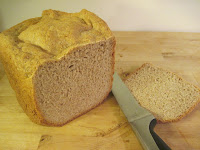I suppose that it was inevitable that I would return to this blog in order to start yapping about my adventures in food. Let's face it, life really isn't worth talking about, especially since nobody really wants to hear about it. I guess that when life is good, so is the food, so let's leave it at that. My previous attempts to scribble about my life seemed rather fruitless. I went back and read my posts, and I was bored silly. I am now going to dedicate this blog to two things that I am sure I would be interested in going back to review. The food that I eat, and the dreams that I have. I will post more of both from now on.
It all started when my mother insisted on sending me an automatic bread machine. Made by Hitachi, she bought the latest and greatest in home appliance technology in 1994 for $150 bucks.

I really didn't want the thing, and did my dog gone-est to avoid it, but somehow it ended up at my house. It has collected dust for quite some time, so I finally elected to get it out and make a loaf of bread, possibly the product of me trying to avoid my Sustainable Development reading by making some kind of attempt at being sustainable. Sure, baking my own bread. Way to go natural-like. Anyway, I flipped through the bread machine recipes and found one that sounded interesting. I have never heard of this type of bread, so it was worth a shot. "Cottage Wheat Bread", a delicious sounding mixture of wheat flour and cottage cheese. I will attempt to both list the recipe, ingredient cost, and total food cost for one loaf of bread. I am hoping that the food economics here will produce some interesting results. Here goes!
The RecipeCottage Wheat Bread - (from Fleischmann's Yeast Bread Machine Favorites)
For 1 pound loaf
2/3 cup milk
1/2 cup cream style cottage cheese1 tbsp butter or margarine
3/4 tsp salt
1 1/4 cup bread flour
1 1/4 cup whole wheat flour
1 tbsp packed brown sugar
1 1/2 tsp Fleischmann's Bread Machine yeast
The ingredients all go into the bread machine, in this order: First the milk, cottage cheese and butter. Then the dry stuff, waiting until the very end to add the yeast on top of the flour, making sure it does not go into the wet stuff. Bread machine is set to basic, light crust, and PRESTO.....off it goes. I will have an update in about 4 hours to let you know what it comes out like.
Food Economics:
Gold Medal Whole Wheat Flour - 5# bag - $3.69 = ( 6.5 oz = .300)
Gold Medal Better for Bread Flour - 5# bag - $3.49 = (6.5 oz = .284)
Fleischmanns Bread Machine yeast - 4oz jar - $8.99 = (1/4 oz = .561)
Imperial Margarine - 1# - $0.99 = (1 tbsp = .030)
Lucerne Whole Milk - 1/2 gallon - $1.99 = (2/3 c = .165)
Knudsen Small Curd Cottage Cheese - 16oz - $3.29 = (4oz = .822) or (.572)**
Brown Sugar - 2# - $2.69 = (3/8oz = .032)
Salt - 26oz - $0.99 = (1/4oz = .010)
Whew! So, there we have it. On the right side is the purchase cost, and in parenthesis, the actual ingredient cost based on the recipe. Add it all up and we get a total of.......
Grand Total = $2.20 per 1 pound loaf of bread !! ** - As you can see, by far, the biggest cost comes from the cottage cheese. I am a bit pissed about that, because the damn grocery store had things priced incorrectly! The cottage cheese should have been $2.29 (I check ALL of my prices). Not to split hairs, but this would have brought the actual cost per loaf down to
$1.95. Well, since they screwed up, I can go back with my receipt, show them the shelf price, and guess what....they have to give me the item for free.
I will update this post in about 4 hours, when the bread is finished.
UPDATEWell, exactly 4 hours and 10 minutes later, the machine beeped and the bread was ready. It was a cube shaped, heavy loaf with a rather hard crust. It smelled wonderful. I sliced it open, and to my surprise, it had a good consistency and looked a lot like, well, wheat bread.

I buttered a slice, and well, it tasted a lot like wheat bread. I could not tell that there was any cottage cheese in it at all. There was no noticeable tang or cheesy flavor. On the good side, it was a very nice loaf, and I like that I can slice it to make nice thick pieces. On the bad side, it did not have any cottage cheese flavor, and well, that was the most expensive ingredient. Next time, I will shoot for some other kind of bread.....stay tuned.



















